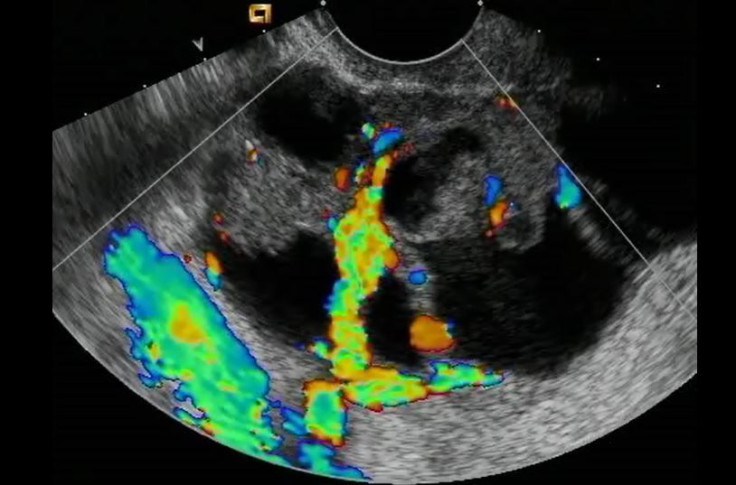Ovarian Cancer Diagnosis: Ultrasound May Better Detect Malignant Adnexal Masses Than MRI

Ovarian cancer is one of the gynecologic cancers that are considered lethal, unless it's caught and treated in its early stages. Early detection and treatment are contingent upon health care providers being able to "preoperatively characterize" the nature of an ovarian tumor, according to a new study published in the American Journal of Obstetrics & Gynecology — for this, they suggest ultrasound examination.
The study analyzed the International Ovarian Tumor Analysis group's Simple Rules, which are based on a set of ultrasound features indicative of both benign and malignant tumors, and have been well-received by clinicians and the Royal College of Obstetricians and Gynecologists in the UK. Separate studies have validated the Simple Rules, finding it applicable in 77 to 94 percent of tumors. And overall, the rules are considered superior to all other methods, study authors wrote. But that's not to say the rules are without its limitations.
"Despite a combination of simplicity and excellent performance, important limitations of the Simple Rules are the inconclusive results in a proportion of cases and the absence of an estimated risk of malignancy," they wrote in the study. "The ability to provide accurate risk estimates is highly relevant for risk stratification and individual patient management. The objective of his study was to develop and validate a model to calculate the risk of malignancy in adnexal masses based on the ten ultrasound features in the Simple Rules."
To do this, the authors conducted an international multicenter cross-sectional study involving approximately 5,000 patients from 22 oncology centers and other hospitals, with at least one adnexal mass (tumor) selected by surgery by the managing clinician. Data was collected through consecutive phases between 1999 2012, including patient results from standardized transvaginal ultrasound and transabdominal sonography (for women with large masses that could not be seen otherwise). The study authors then applied the Simple Rules based on certain variables, such as the diameters of the lesion, the diameters of the largest solid component, and the type of tumor.
The malignancy rate was 34 percent overall, study authors found; 43 percent in oncology centers and 17 percent in other centers. Results also revealed the median age of patients with a benign tumor was 42 years old, while the median age for patients with a malignant tumor was 57.
"The Simple Rules are intuitively attractive because of their ease of use," the authors wrote. "However, when used as originally suggested they allow only a categorization of tumors into three groups: benign, malignant or inconclusive. In this study, we show that the Simple Rules can also be used to estimate the risk of malignancy in every adnexal mass and so can be used for individualized patient management."
The authors mention the type of center patients visit has to be included in overall risk estimation, "because the risk of a malignant tumor is higher in oncology centers than in others."
While imaging is vital to identifying potentially malignant tumors, Dr. Beryl Benacerraf, president of the American Institute of Ultrasound in Medicine (AIUM) and clinical professor of radiology and OB GYN at Brigham and Women's Hospital in Boston, explained in an accompanying editorial that it's been difficult to find an ultrasound algorithm that works as sufficiently as magnetic resonance imaging (MRI). But, he said, the present study successfully takes this complex problem and simplifies it, demonstrating ultrasound can better identify tumors than MRI.
"The investigators have finally been able to level and elevate the playing field so that everybody can practice with expert results in this regard," Benacerraf said. "Not only have the five simple rules demonstrated that you don't have to be an expert to evaluate ovarian masses accurately, but that one can do so simply, reproducibly and reliably."
There's no way to prevent ovarian cancer, accordin to the Centers for Disease Control and Prevention, further emphasizing the importance of early detection and treatment. Past research has suggested women can reduce risk through healthy diet and increase survival rates with certain medication, but for the most part, the CDC recommends women pay attention to their body and immediately see a doctor when they noticed abnormal changes. Signs and symptoms include pelvic and abomdinal pain, back pain, being tired all the time, bloating, and any change in bathroom habits, such as frequent urination and abnormal vaginal discharge.
Study authors hope their findings help oncology and health centers better facilitate choosing the optimal treatment for all patients presenting with ovarian tumors.
Source: Timmerman D, Van Calster B, et al. Predicting the risk of malignancy in adnexal masses based on the Simple Rules from the International Ovarian Tumor Analysis (IOTA) group. American Journal of Obstetrics & Gynecology. 2016.



























